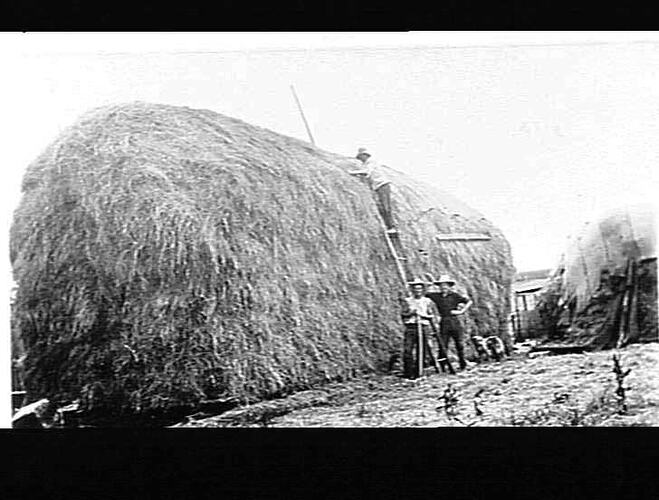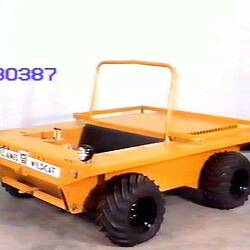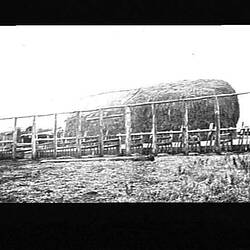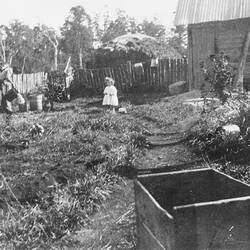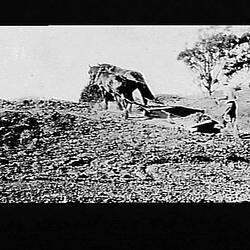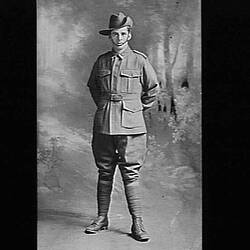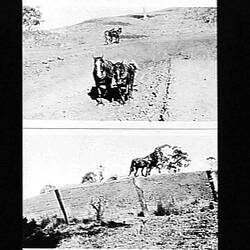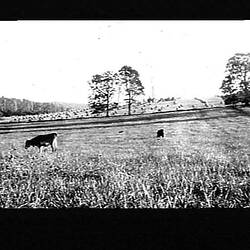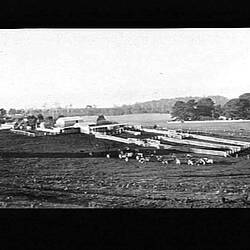Summary
Covering a loose haystack made by Frederick Charles Williames (1893-1985) on his property at Hill End (Gippsland), Victoria, circa 1918. The worker standing on top of a farm-made ladder is fixing a termporary cover made of tarred sewn bags over the loose hay. The completed stacks were finished with the 'straws' or stems in the outer layer of hay hanging downwards to shed the rain more efficiently. The harvest hands 'combed' down the straws with the hay fork. Hay for the sacks was obtained from pasture fertilized with superphosphate, cut by horsedrawn mower, windrowed with a horsedrawn rake, then gathered into conial hay 'cocks' for air drying, prior to be carried to the stack on a netting sled.
The Williames collection includes two other similar views, but of oaten hay, circa 1925, one showing a large wheeled wagon with saplings lashed to it to increase its capacity.
Frederick Charles Williames was born at Brighton, Victoria, in 1893, being third of five children for parents Walter Frederick Williames (1862-1911) and Mary Ellen Williames (neé Tharratt) (1870-1944). By the time his father died in 1911, aged just 49, the family had relocated to Hill End, in West Gippsland, where they were engaged in dairy farming. Frederick Charles Williames enlisted in the AIF in July 1915, at the age of 21, describing himself as a farmer, with his mother given as next of kin. He was placed in the 12th Reinforcements of the 2nd Field Company, Engineers, service no. 2526, becoming a driver and served in France. He suffered several bouts of illness, but returned safely to Australia in May 1919, to resume his farming career. He developed the Hill End property into a flourishing dairy farm and later owned others properties near Moe. During the 1960s he joined his nephew Mr G.A. Williames in a Warragul based venture producing the 'Williames Wildcat' all-terrain light tractor. He died at Prahran, Victoria, in 1985.
Description of Content
Three men covering hay stacks with tarred corn sacks. One man is standing on a wooden ladder against the larger haystack, while the other two men are standing at the foot of the ladder with a dog nearby. A second stack with a completed cover is partially visible at right.
Physical Description
Black and white negative.
More Information
-
Collection Names
-
Collecting Areas
-
Maker of Item Depicted
Driver Frederick C. Williames - Australian Imperial Force (AIF), Hill End, Gippsland, Victoria, Australia, pre 1920
-
Format
Negative, Black & White
-
Classification
Agriculture & rural life, Crop management - handling & storage, Hay stacks
-
Category
-
Discipline
-
Type of item
-
Keywords
Primary Production, Hay Stacks, Harvesting, Harvesting Equipment, Hay Stack Covers, Farm Workers, Ladders
